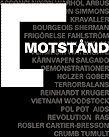Resistance: then and now

Resistance: then and now
What does “resistance” mean to you?
Is it an anachronism from the 1960s and ’70s – from a time when distinctions of left and right were clearly drawn? Or is it still alive? The question might be rephrased. Has resistance been an integral part of the task of contemporary art, from then, and long before, until now? Just think of the social and aesthetic impact of Géricault’s The Raft of the Medusa or Delacroix’s Liberty Leading the People – large paintings which not only reflected deep social conflict but which also, in a sense, gave it form? Does this impulse stem from an almost compulsive need to be what the French Symbolist writer J-K Huysmans described as à rebours, against the grain? Has this, in fact, been one of the ways in which modern art has always made itself special, separate from, yet also intimately connected with, the concerns of everyday life?
Text: David Elliott
This gallery and the one adjacent to it shows the exhibition The Path of Resistance, chosen by Susan Kismaric and Joshua Siegel from the collections of the Museum of Modern Art in New York as well as a selection of related works from the collection of Moderna Museet. These examine the complexity of the relationship between art and resistance, tracing its evolution and context over the past forty years. The power of young people as an innovatory force is an important part of this and first became evident in western Europe and the USA during the 1960s and continues to the present. As you can see from the early posters, comix and magazines produced by Sture Johannesson, Kjartan Slettemark, Lars Hillersberg, Lena Svedberg and Robert Crumb sexual liberation or smoking pot became equivalents of striking a blow against inflexible and deadly authority – a struggle which Öyvind Fahlström relentlessly pushed to its extreme limits in his scathing attacks on the effects of world capitalism. Today the oedipal influence is less self-assured although just as energetic. The new generation, as expressed in the work of Lotta Antonsson, Ellen Gallagher and Johanna Billing for example, is less prescriptive and more analytical. The oppression of sexual and ethnic stereotypes are confronted here as well as the apparently apolitical attitudes of a generation that has been drowned in ideology by its fathers and mothers.
In the timeframe of these exhibitions we see a clear move away from an idea of opposition based on ideological issues – solidarity in class conflict, antagonism to imperialism or opposition to totalitarianism for example – towards a less clear cut but no less sincerely held commitment to ethical and environmental issues in which the voice and fate of the individual rather than that of the collective is of prime importance.
It was during the late 1960s and early 1970s that this first became evident. Before then a clear line had been drawn on both the extreme Left and Right between the individual and a form of politics that claimed to speak for everyone. All of a sudden a new slogan “the personal is the political” seemed to unleash a torrent of work made by women and men which centred on the importance of the human body as a metaphor for liberation in every possible sense. The Body Politic and the Body Personal interact in the grey zones of freedom: in the paradox that the freedom of some individuals may lead to the oppression of the multitude as well as to its reverse: that the dominance of the multitude may lead to the biggest tyranny of all.
Good art has always had an equivocal relation to power: a necessity to both lick and bite the hand that feeds it. Getting this proportion right is an art in itself and, of course, it changes in different places, times and contexts. Dramatic transformations in the world at large have, over the past fifteen years, mapped changes in power and the recent resurgence of anarchism reflects a growing mistrust of formal structures of all kinds. Power wears global as well as national masks and it is perhaps not now as visible as it once seemed. The blind pursuit of profit can ravage the environment, deprive a large part of the world of the drugs it needs to fight disease or lead to the oppression of low wages and unemployment. But it is the symptoms rather than the perpetrators of these ills of which we are constantly aware. Artists often deal with this through allusion or metaphor as in the case of David Hammons’s African-American Flag (MoMA) or African Stand, Eugenio Dittborn’s Technical Memories or To Spill II. Or Doris Salcedo’s untitled concrete filled bed. It is no longer so easy to believe in icons of “good” and “bad”, in heroes or villains. The world is more complicated than that and the survival of millions is at stake without there even being a war. Today there are no Kennedies, Nixons, Kruschevs, Ches, Thatchers, Hos, Envers or Maos and our heroic socialist realism is filtered first by the Pet Shop Boys. A belief that responsibility for our futures could lie with such symbols seems not only naïve but also camp.
